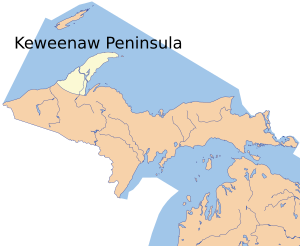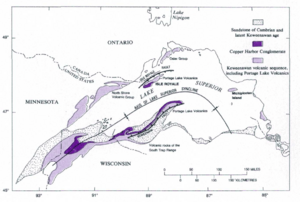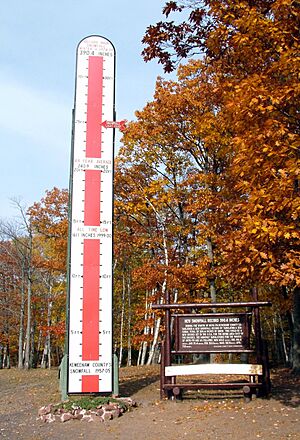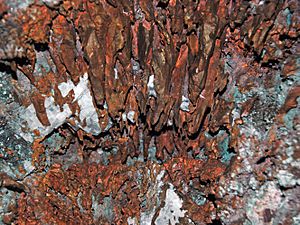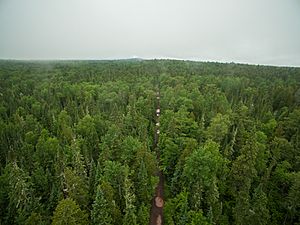Keweenaw Peninsula facts for kids
The Keweenaw Peninsula is the most northern part of Michigan's Upper Peninsula. It sticks out into Lake Superior. This area was famous for the first big copper boom in the United States. Because of this, people often call it "Copper Country." Today, about 43,200 people live here. The main jobs are in logging and tourism. Many people also work at Michigan Technological University and Finlandia University.
Contents
What is the Keweenaw Peninsula Made Of?
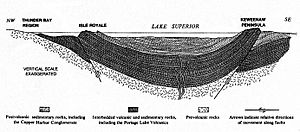
The Keweenaw Peninsula was formed by ancient lava flows. This happened about 1.096 to 1.087 billion years ago. It was part of a huge crack in the Earth called the Midcontinent Rift. This volcanic activity created the only place on Earth where you can find very pure native copper in large amounts. This copper is 97 percent pure!
Much of the native copper here looks like "lacy" fillings in old lava rock. You can also find it as solid pieces called "float" copper. Sometimes, copper ore is found inside conglomerate rock. These are layers of rock made from pebbles and sand.
The Keweenaw Peninsula and Isle Royale are special places. They are the only spots in the U.S. with proof of ancient people mining copper. Native Americans traded tools and jewelry made from this copper far away. Some items traveled as far south as present-day Alabama. Also, chlorastrolite, Michigan's state gem, is only found in these areas.
The very northern tip of the peninsula is sometimes called Copper Island. Finnish immigrants called it "Kuparisaari." This name is not used as much anymore. A natural waterway, the Keweenaw Waterway, separates it from the rest of the peninsula. This waterway was dug deeper and made wider in the 1860s. It runs between the cities of Houghton and Hancock.
There is a Water Trail around Copper Island. It is about 125 miles (201 km) long. You can paddle this trail in five to ten days. This depends on the weather and water conditions.
The Keweenaw Fault is a long crack in the Earth's crust. It runs through Keweenaw and Houghton counties. This old geological fault created tall cliffs. U.S. Highway 41 and Brockway Mountain Drive were built along these cliffs.
Weather in the Keweenaw Peninsula
Lake Superior greatly affects the weather here. It makes winters milder than in nearby areas. Spring is cool and short. Summer temperatures usually reach around 70°F (21°C). Fall starts in September, and winter begins in mid-November.
The peninsula gets a lot of lake-effect snow from Lake Superior. Official snow records are kept near Hancock, Michigan. The average snowfall there is about 220 inches (559 cm) each year. Farther north, in Delaware, the unofficial average is about 240 inches (610 cm). In 1979, Delaware had a record snowfall of 390 inches (991 cm) in one season! Higher areas closer to the tip of the peninsula likely get over 250 inches (635 cm) of snow on average.
History of the Keweenaw Peninsula
Native Americans started digging for copper here about seven thousand years ago. This activity was biggest around 3000 B.C. They could do this because large amounts of copper were easy to find. It was in surface rocks and shallow holes. Native copper was found as big nuggets and thin, wiry pieces.
Around 3000 B.C., copper became popular for making tools. Later, around 1200 B.C., people started using copper more for decorations. Native Americans would heat the rock around copper with fire. Then, they would pour cold water on it to crack the rock. After that, they would pound the copper out using rock hammers and stone chisels.
Large-scale mining of copper (and some silver) began in the mid-1800s. This industry grew and employed thousands of people into the 1900s. Hard rock mining stopped in 1967. However, copper sulfide deposits were still mined for some time in Ontonagon. This busy industry needed skilled mining experts. This led to the founding of the Michigan Mining School in Houghton in 1885. Today, it is called Michigan Technological University.
At the same time as the mining boom, there was also a white pine lumber boom. Trees were cut to make timbers for mine shafts. They were also used to heat homes and help build the growing nation. Much of the logging happened in winter because the snow made it easier to move logs. Because of how logging was done back then, the forests of the Keweenaw look very different today.
US 41 ends in the northern Keweenaw at a Michigan State Park. This park is home to Fort Wilkins. US 41 was once called the "Military Trail." It started in Chicago in the 1900s and ended in the wild Keweenaw. The restored fort has many interesting exhibits.
From 1964 to 1971, the University of Michigan and Michigan Technological University worked with NASA and the U.S. Navy. They ran the Keweenaw Rocket launch site here.
Communities in the Keweenaw Peninsula
Here is a list of some towns in the Keweenaw Peninsula:
|
|
|
Images for kids
-
Mostly sunny conditions over the peninsula, taken at 2:07:45 PM Central Daylight Time on October 8, 2019 from the ISS


